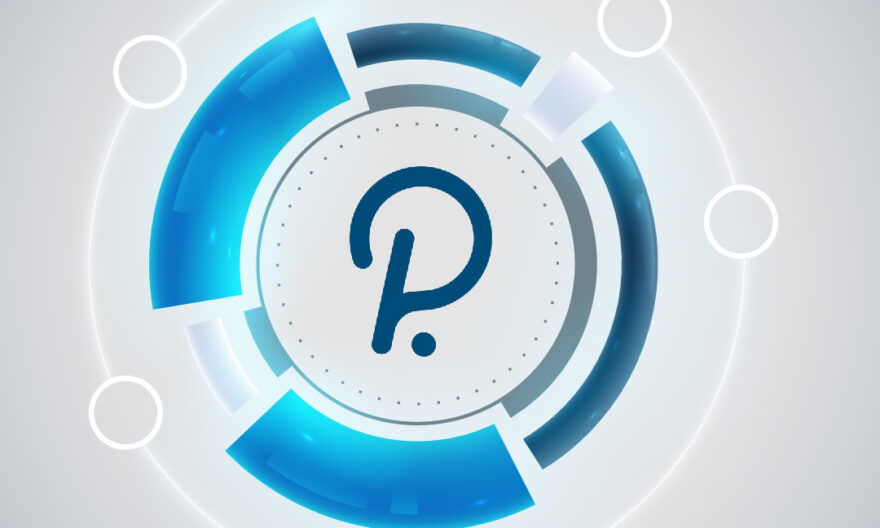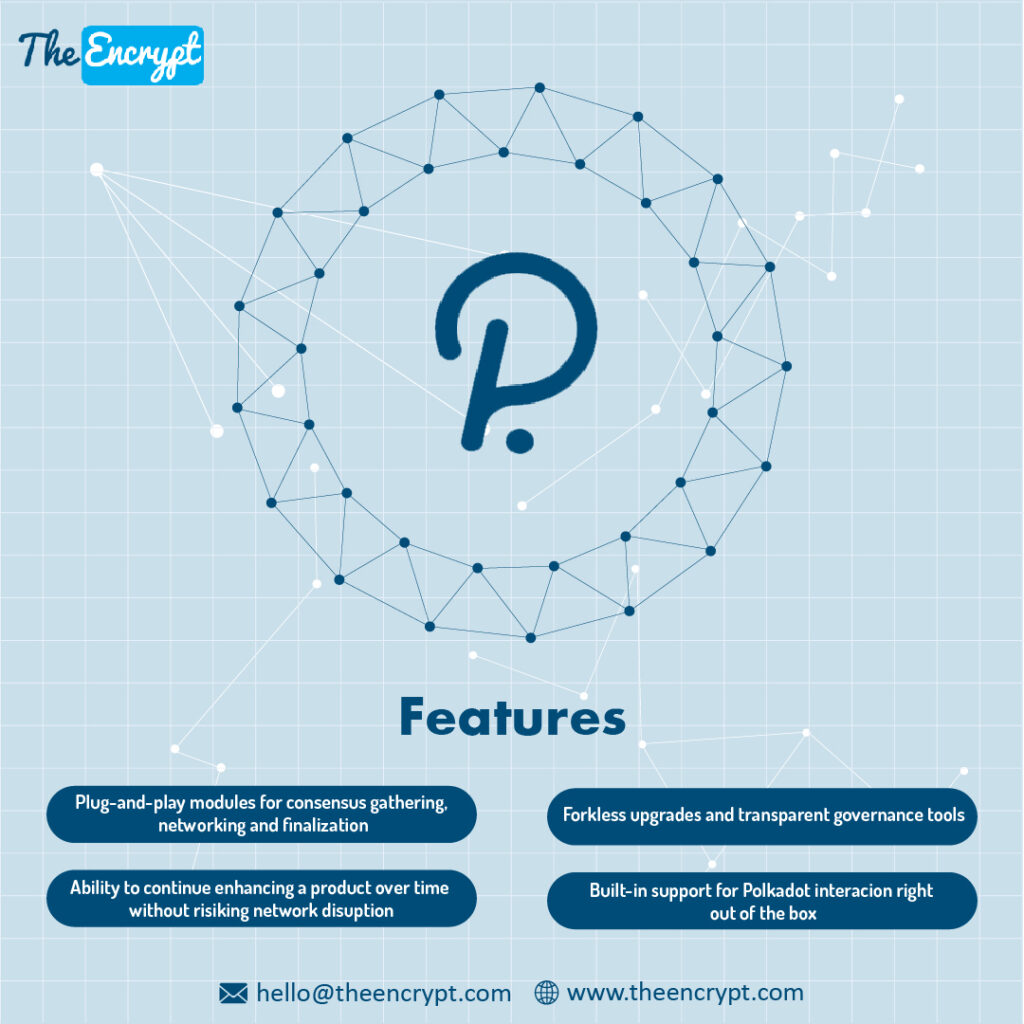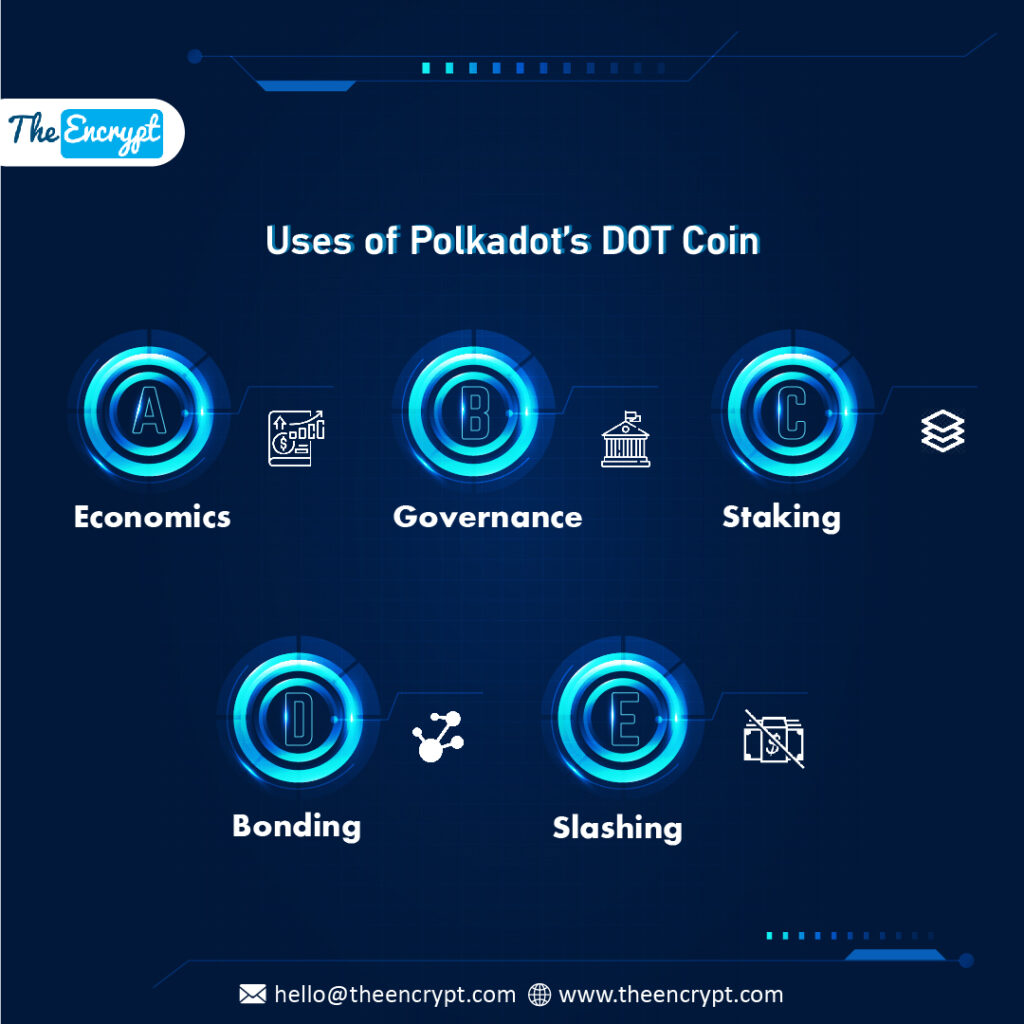
Polkadot is an advanced cryptocurrency project that uses blockchain technology to build a decentralized, distributed, and heterogeneous multi-chain infrastructure. It’s one of the most cutting-edge cryptocurrency projects, and investors, developers, and users are very interested in it.
The Polkadot ecosystem uses the DOT token to make transactions safe and scalable. It solves many of the problems that blockchain technology is having right now. It’s a good way to put the specific features of the technology to use simultaneously. The project was first thought of in 2016, but it took until now to make it happen. When Polkadot got added to Coinbase, the DOT coin wasn’t available until August 2020 and wasn’t widely accepted until June 2021.
Polkadot will be new because Blockchains are different from other ways of keeping records. As they are decentralized, transactions happen quickly, and you can’t trust the system. Even though many blockchains do support one or more of these unique features, most are only built to handle some of them simultaneously.
Examples of uses of Polkadot
For example, Ethereum has become the blockchain that most decentralized apps use. But it needs to be more scalable and has very high costs, especially when the platform is used the most. But EOS gives up decentralization for the convenience of instant transactions with no fees.
These many networks don’t share much information. If, for example, banks were not allowed to talk to each other, it would be hard to move money between financial institutions. Think about your inbox as you write this.
For example, because they work well together, it’s easy to move emails from Yahoo to Gmail. Lack of interoperability is now one of the main reasons why blockchain technology is used less widely. Polkadot is a way to deal with this problem.
What does the Polkadot network mean in cryptocurrency?
Polkadot (DOT) is a blockchain’s central network or relay chain, which is how other blockchains connect and talk to each other. By hosting blockchains and processing their transactions, the relay chain ensures that cross-chain interoperability is safe and works well. Polkadot not only lets users move DOT tokens between blockchains, but it also lets them move real data between each other.
It means that interoperability is the biggest problem Polkadot is trying to solve. Blockchains should be into existing systems instead of standing alone. It will ensure that data and money transactions are safe, scalable, and private. Polkadot even takes care of the problem of inter-blockchain communication. It is hard because public and private blockchains use different technical protocols. Polkadot’s network architecture is flexible and easy to change. It is great for developers due to the platform’s scalability, interoperability, and security.
Polkadot’s network is also a big step forward for developers and business owners who want to start from scratch and make a whole new blockchain. To make a new blockchain, you must make a new state machine and consensus algorithm. Neither of these things is easy or quick. Polkadot’s design from the ground up tries to solve this problem by eliminating the need for people to make their blockchains.
A blockchain built in Polkadot uses the modular structure of Substrate. It lets users plug in the needed features and update them as their needs change. Moreover, it also lets developers change the architecture of the chain to fit their needs. It lets them choose which parts to use and link blockchains to other networks like Ethereum and Bitcoin.
How Does It Function?
Polkadot has something called “para chains,” which are parallel blockchains, and a “core network” (the relay chain). Let’s learn more about the network’s structure and the technical parts of the system to see how they all work together. The protocol of the relay chain controls both the network’s ability to reach a consensus and the ability of different chains to talk to each other. It is the network’s backbone.
It connects all the other nodes and ensures that all transactions are safe. The relay chain was as simple as possible on purpose. For example, smart contracts are not supported, and the chain’s main job is coordinating the whole system. It will include parachains. For simplicity, we’ll call parallelized chains “parachains” for short. They can be independent blockchains because they have their coins, rules, and applications.
So, parachains depend on the relay chain’s trustworthiness and compatibility. It ensures to ensure that all transactions get complete. Thanks to the relay chain, Parachain’s system works perfectly. It gives developers and users more time, energy, and resources to focus on complex issues. It may include privacy or scalability and the uses for which they are useful.
One of the best things about Polkadot is that para chains can use it to make fast, scalable, and safe transactions. To join Polkadot’s network, para chains must rent one of the hundred available slots. Since Parachain only has limited space, getting a slot may become hard.
The Six Defining Features of a Polkadot

Let’s go over Polkadot’s main features so that you can understand its value and potential:
Universally Compatible Environment
Polkadot makes transactions between chains easy. Polkadot’s cross-chain architecture allows it to do more than transfer money. For example, data and assets can transfer between blockchains. By connecting to Polkadot, many blockchains can work with each other on the Polkadot crypto network.
Scalable Ecosystem for Transactions and the Economy
The validators in Polkadot’s linked network use a technology that can get scaled up to keep different blockchains safe and in agreement. By spreading network trades across many parallel blockchains, the technology makes it possible to increase the number of transactions and be faster.
Creating Blockchain Applications in a New, Efficient Way
Polkadot’s Substrate is a blockchain development platform that makes building blockchain networks faster for developers. By integrating with Polkadot, other blockchains can take advantage. It can be of its advanced security design and real interoperability while enjoying the benefits of streamlined application development.
Modular, Expandable, and Forkless Structure
Because it can update itself, the Polkadot network can quickly add new features and fix problems without splitting. Because it can get updated, Polkadot will continue to do well even as better tools come out to expand blockchain’s capabilities.
Adaptable, Safety-First Ecosystem
The Polkadot blockchain protocol makes accessing and understanding data easier. It does it by allowing for decentralized governance and communication between blockchains. It strengthens the security of each network.
Decentralized Governance Model
Polkadot has a sophisticated way of making decisions, and everyone in the ecosystem has a say in how things will run. Polkadot’s growth is a democratic reflection of the community’s shared values. Hence, the network’s on-chain updates get decentralized.
Also read: Top Web 3.0 projects to keep an eye on
The usefulness of Polkadot’s DOT Coin

In the Polkadot ecosystem, the DOT token serves five primary functions:
● Economics:
DOT helps incentivize nodes to participate in the network’s consensus process, finance the ecosystem’s treasury, and regulate the asset’s inflation rate.
● Governance:
As the primary blockchain network for Polkadot, the Relay Chain is where DOT token holders have a role in ensuring the legitimacy of on-chain protocol decisions.
● Staking:
Putting DOT up as collateral in exchange for a return incentivizes validators to keep the network secure and in agreement.
● Bonding:
DOT currencies are a rent-like method to choose which para chains receive para chain slots that one may use to attach to the Relay Chain. An auction and staking/deposit system is used in this method. See the page on Polkadot’s technical structure for further details on bonding.
● Slashing:
In the Polkadot blockchain network, DOT is essential for slashing validators and nominators. It is for those who engage in harmful activity by assaulting other nodes or engaging in unjustified actions.
Polkadot Network: Why Do We Need It?
A small number of large companies are in charge of running the Internet today. Blockchain technology can help with decentralization, but it can’t be used in traditional networks. It is because of problems with compatibility. Polkadot is the next generation of Blockchain technology that can make a fully decentralized network.
Polkadot, like any other Blockchain ecosystem, wants a decentralized web. It aims that a small group of firms doesn’t have monopoly power over how users interact with technology. It wants to ensure that there are no compromises on users’ data security and privacy for its gain. If you want to use a program or service online these days, you have to agree to a long list of rules.
Since we can’t agree or disagree with these rules, we usually don’t even bother to read them. If we want to use an app or web tool, we must agree to the terms that come with it. As we continue to do this, we produce mountains of valuable data that give a deep look into our lives. It means that we trust the companies to keep our information safe and give them free access. Before, there wouldn’t likely be decentralized web systems, but recent improvements in open source and other decentralized technologies have made this possible.
A decentralized internet could stop big companies from having a monopoly and protect people’s freedom. Even though blockchain is one of the most disruptive technologies in recent history, some things still make it hard to use in the real world. These rules are mainly in place because blockchain ecosystems now run.
Areas where Polkadot is used
Blockchains have much potential in areas like the IoT, finance, government, tracking assets, managing identities, and making the Internet less centralized. But the best parts of these different networks can’t be put together because they need to share information. Many people need help using a blockchain because of this technical problem.
The Polkadot protocol is a cross-chain solution. It aims to make it easier for blockchains to work together by letting data move between them.
Polkadot vs. Bitcoin
Polkadot network and Bitcoin differ in their work and what they want to achieve. It wants to become a multi-chain platform. It wishes to let blockchains exchange tokens, data, and messages. Also, it will help Bitcoin become the first global decentralized network for payments.
Polkadot is looking into possible network protocols to make it easier for data to move between blockchains. So, a Bitcoin company likes the idea of an alternative payment system and currency based on blockchain. The main differences in technology are the mining process and the consensus method. Bitcoin uses “proof-of-work,” while Polkadot uses “nominated proof-of-stake.”
Ethereum vs. Polka Dot
Ethereum is an operating system for running smart contracts, and its goal is to become a distributed ledger for money transfers. So, the Polkadot platform offers a way to build custom blockchains and make different networks work together quickly. Both technologies focus on developers making distributed applications and trying to fix scalability.
Ethereum does this with shards, while Polkadot does it with para chains and threads. Ethereum’s consensus system depends on proof of work, just like Bitcoin’s. In contrast to Polkadot’s NPoS, the proof-of-stake system will be used when the 2.0 update comes out.
Polkadot vs. Cardano
Cardano and Polkadot are alternatives to Ethereum that try to fix some of its problems. They have the same background because they were both made by important people in the Ethereum community. Cardano (ADA) is a third-generation blockchain platform that can be used by people who want to make decentralized apps.
It is the first proof-of-stake blockchain platform based on academic research. Additionally, it is built using empirical methods. It uses cutting-edge technology to ensure that distributed programs are safe and will last long. So, we now know that Polkadot is an application ecosystem for many chains, a blockchain, and a cryptocurrency. The network made cross-chain interoperability easier to build the next generation of DApps.
Summary
Polkadot is a type of digital currency that is easy to get. One can buy DOT on most of the world’s top cryptocurrency exchanges. It means developers who want to bid on a Polkadot para chain and people who want to speculate can buy it.
The Osprey Polkadot Trust (ODOT) gives investors access to Polkadot. Hence, it gets traded on the over-the-counter market. After getting DOT tokens, one can keep them in a digital asset wallet. You can store your cryptocurrency either online (in a “hot wallet”) or offline (in a “cold wallet”).
With online wallets, theft is more likely to happen. Check if Polkadot tokens can get stored in your chosen cryptocurrency wallet. Investing in Polkadot is risky and based on much speculation, just like investing in any other cryptocurrency. Before you buy DOT tokens, it’s a good idea to talk to a financial planner. Because there is a high chance of losing money when you invest in cryptocurrency, you should only invest what you can afford to lose.
Also read: Future of Web 3.0
